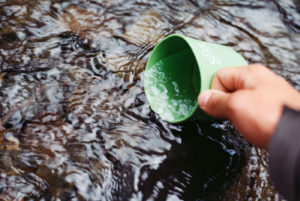Native Fish Conservation Areas (NFCA)
Native Diversity - Healthy Habitat - Sustainable Management
The Wichita River, as seen from Lucy Park in Wichita Falls, Texas
Four critical elements need to be met within a NFCA
1
Maintain processes that create habitat complexity, diversity, and connectivity;
2
Nurture all of the life history stages of the fishes being protected;
3
Include a large enough watershed to provide long-term persistence of native fish populations; and
4
Provide management that is sustainable over time.
(Jack E. Williams et al, Fisheries, Vol. 36, No. 6, June 2011, www.fisheries.org)
Native Fish Conservation Areas
Conservation organizations are identifying networks of protected watersheds to address fish conservation needs in river basins nationwide. From 2004 – 2014, federal and state organizations in the Southeastern United States have successfully implemented 126 fish habitat protection, restoration, and enhancement projects. These projects restored fish habitats in 480 km of rivers, restored or protected 3,900 ha of riparian and upland habitats in priority watersheds, and removed or redesigned 7 dams or other instream barriers, restoring fish passage in 68 km of rivers. These investments primarily centered on restoring and preserving natural watershed conditions (e.g., natural land cover, natural patterns in instream flows) and related physical processes (e.g., groundwater recharge and spring flows, watershed connectivity, and sediment transport) that in turn influence the condition of fish habitats and the ability of native fish populations to persist.
Communication
 Critically important to the success of these regionally-focused conservation partnerships has been the ability to facilitate communication and cooperative planning among local, state and federal natural resources management agencies, non-governmental organizations, and other stakeholders. This collaborative planning allows for identification of shared geographic (e.g., ecoregions, watersheds) and thematic (e.g., water quality, watershed connectivity, focal species) priorities and supports strategic investments and leveraging of available technical and financial resources, often allowing for significant expansion of the scope and scale of local conservation projects (e.g., extent of watershed restored and inclusion of project-based monitoring or applied research necessary to evaluate and improve restoration designs).
Critically important to the success of these regionally-focused conservation partnerships has been the ability to facilitate communication and cooperative planning among local, state and federal natural resources management agencies, non-governmental organizations, and other stakeholders. This collaborative planning allows for identification of shared geographic (e.g., ecoregions, watersheds) and thematic (e.g., water quality, watershed connectivity, focal species) priorities and supports strategic investments and leveraging of available technical and financial resources, often allowing for significant expansion of the scope and scale of local conservation projects (e.g., extent of watershed restored and inclusion of project-based monitoring or applied research necessary to evaluate and improve restoration designs).
Case Studies
Groups like Texas Parks and Wildlife Department, along with academic and federal partners, have implemented several successful case studies in multi-jurisdictional, watershed-scale conservation planning and delivery that have demonstrated holistic, integrated, and multi-species approaches to conservation of aquatic resources (Birdsong et al. 2015, Garrett et al. 2015). These case studies highlight the value of a watershed-based approach in assembling and integrating interdisciplinary perspectives and expertise (e.g., aquatic biology, terrestrial ecology, fluvial geomorphology, public policy, fundraising, advocacy) and in integrating formerly disjunct planning efforts such as state-based conservation planning activities that may only consider the portion of a multi-jurisdictional watershed or species range contained within that state. As conservation organizations and stakeholders expand this watershed-scale approach to other watersheds of the Great Plains, assessments and decision support tools are needed that help prioritize watersheds based on value in preservation of regional fish diversity and that help facilitate multi-species, watershed-scale conservation planning and delivery.
